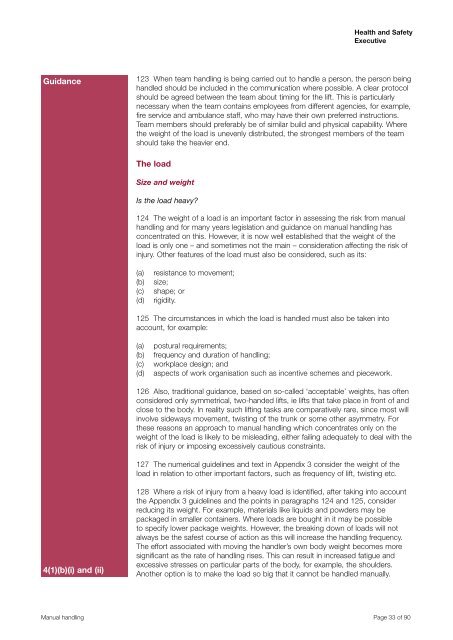Manual Handling Manual Handling Operations Regulations 1992 ...
Manual Handling Manual Handling Operations Regulations 1992 ...
Manual Handling Manual Handling Operations Regulations 1992 ...
You also want an ePaper? Increase the reach of your titles
YUMPU automatically turns print PDFs into web optimized ePapers that Google loves.
Health and Safety<br />
Executive<br />
Guidance<br />
123 When team handling is being carried out to handle a person, the person being<br />
handled should be included in the communication where possible. A clear protocol<br />
should be agreed between the team about timing for the lift. This is particularly<br />
necessary when the team contains employees from different agencies, for example,<br />
fire service and ambulance staff, who may have their own preferred instructions.<br />
Team members should preferably be of similar build and physical capability. Where<br />
the weight of the load is unevenly distributed, the strongest members of the team<br />
should take the heavier end.<br />
The load<br />
Size and weight<br />
Is the load heavy?<br />
124 The weight of a load is an important factor in assessing the risk from manual<br />
handling and for many years legislation and guidance on manual handling has<br />
concentrated on this. However, it is now well established that the weight of the<br />
load is only one – and sometimes not the main – consideration affecting the risk of<br />
injury. Other features of the load must also be considered, such as its:<br />
(a)<br />
(b)<br />
(c)<br />
(d)<br />
resistance to movement;<br />
size;<br />
shape; or<br />
rigidity.<br />
125 The circumstances in which the load is handled must also be taken into<br />
account, for example:<br />
(a)<br />
(b)<br />
(c)<br />
(d)<br />
postural requirements;<br />
frequency and duration of handling;<br />
workplace design; and<br />
aspects of work organisation such as incentive schemes and piecework.<br />
126 Also, traditional guidance, based on so-called ‘acceptable’ weights, has often<br />
considered only symmetrical, two-handed lifts, ie lifts that take place in front of and<br />
close to the body. In reality such lifting tasks are comparatively rare, since most will<br />
involve sideways movement, twisting of the trunk or some other asymmetry. For<br />
these reasons an approach to manual handling which concentrates only on the<br />
weight of the load is likely to be misleading, either failing adequately to deal with the<br />
risk of injury or imposing excessively cautious constraints.<br />
127 The numerical guidelines and text in Appendix 3 consider the weight of the<br />
load in relation to other important factors, such as frequency of lift, twisting etc.<br />
4(1)(b)(i) and (ii)<br />
128 Where a risk of injury from a heavy load is identified, after taking into account<br />
the Appendix 3 guidelines and the points in paragraphs 124 and 125, consider<br />
reducing its weight. For example, materials like liquids and powders may be<br />
packaged in smaller containers. Where loads are bought in it may be possible<br />
to specify lower package weights. However, the breaking down of loads will not<br />
always be the safest course of action as this will increase the handling frequency.<br />
The effort associated with moving the handler’s own body weight becomes more<br />
significant as the rate of handling rises. This can result in increased fatigue and<br />
excessive stresses on particular parts of the body, for example, the shoulders.<br />
Another option is to make the load so big that it cannot be handled manually.<br />
<strong>Manual</strong> handling Page 33 of 90
















